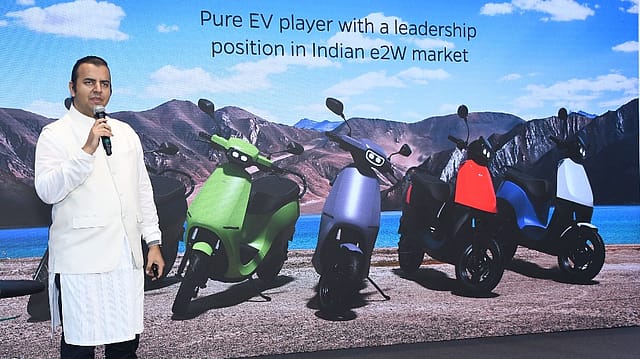Ola opens 3,200 new outlets as it loses EV crown to Bajaj
ADVERTISEMENT

Bhavish Aggarwal-led Ola Electric expanded its store count from 800 to 4,000 outlets on Christmas Day as the electric vehicle maker trails legacy player Bajaj Auto in EV sales in December.
Bajaj Auto has sold 15,203 EVs in December so far compared with 11,385 units sold by Ola Electric, according to registration data sourced from Vahan.
TVS Motor Company, too, has sold more EVs than Ola during the month so far. The Hosur-based two-wheeler maker sold 13,811 EVs in December. Hero MotoCorp-backed EV startup Ather Energy has clocked 8,410 registrations till December 25.
Ola’s store expansion comes at a time when legacy automakers are chipping away at the new-age company’s market share. Bajaj and TVS already have a robust dealership network across the country. With 3,200 new stores, Ola Electric is looking to operate India's largest EV distribution network covering all pin codes. These will also come in handy as the company rolls out electric motorcycles next year.
In the calendar year 2024, Ola still led in EV sales, followed by TVS Motor Company.
Yet, it hasn’t been a smooth ride for Ola. The company received a show cause notice from fair-trade watchdog Central Consumer Protection Authority (CCPA) for alleged violation of consumer rights, misleading advertisement and unfair trade practices after complaints on long service delays by customers went viral on social media.
December 2025
The annual Fortune 500 India list, the definitive compendium of corporate performance, is out. This year, the cumulative revenue of the Fortune 500 India companies has breached $2 trillion for the first time. Plus, find out which are the Best B-schools in India.
Ola says its 3,200 new stores will be co-located with service facilities.
EVs currently account for only 5% of two-wheeler sales in India and 20% of total scooter sales. The government’s is targeting 80% electrification in two-wheelers by 2030.
To increase volumes, Ola Electric is eyeing the light-weight commuter motorcycle segment which constitutes 75% of India’s two-wheeler sales. On August 15, Ola Electric founder and chairman Aggarwal showcased the ‘Roadster’ series of electric motorcycles with prices starting from ₹74,999 and going up to ₹2,49,999. Two-thirds of India’s two-wheeler market consists of motorcycles, and with Ola’s entry into this segment, EV penetration is poised to further accelerate in the Indian 2W segment, Aggarwal said at the time
While automakers—legacy and start-ups alike—are ramping up EV volumes, profits still elude electric vehicles. Ola Electric’s net loss widened 7.6% to ₹1,584 crore in FY24. Bajaj’s electric two-wheeler business is also not profitable.
"One thing which is not in our hands is product pricing," says Dinesh Thapar, chief financial officer, Bajaj Auto. Prices of electric two-wheelers have only come down in recent months. In November, Ola launched its cheapest EV, the Gig scooter with prices starting from ₹39,999.
Bajaj’s Thapar says these price reductions have outstripped the cost cuts, making EVs a drag on profitability. “We have a full-fledged programme in place on value engineering and rationalising cost lines but the eventual profitability will be a function of where consumer pricing settles down,” explains Thapar. Profitability of electric two-wheelers is still some distance away if this is where consumer pricing is likely to be at, he says.
